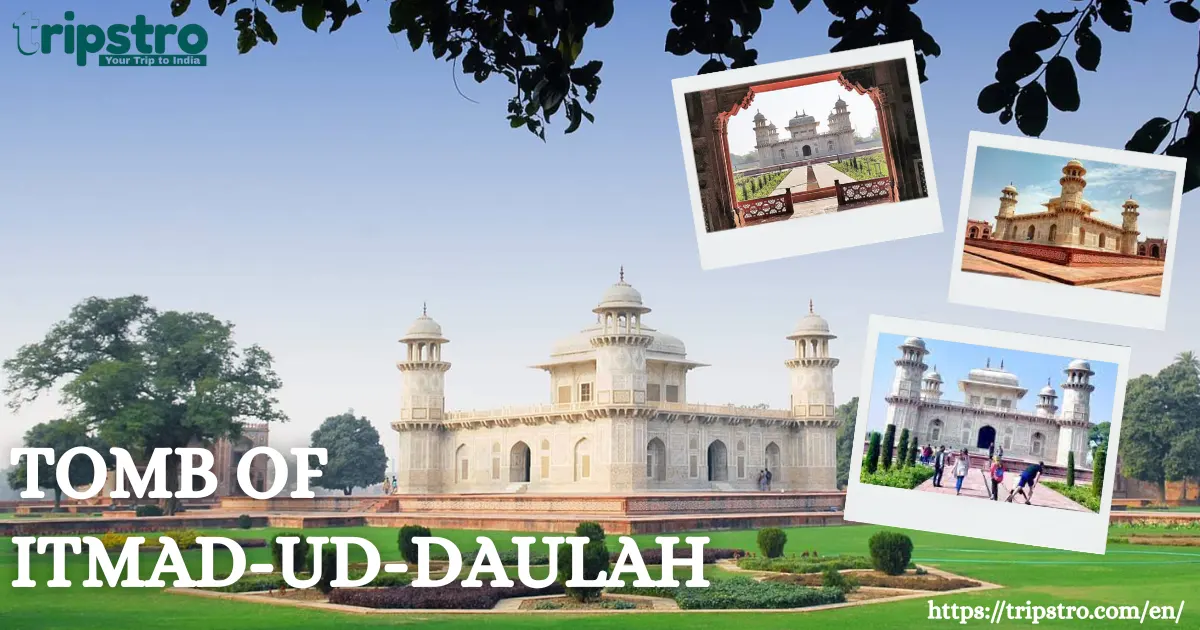The Tomb of Itmad-ud-Daulah is often overshadowed by the grandeur of the Taj Mahal, yet it is one of the most fascinating monuments in Agra. Often referred to as the Baby Taj, this marble mausoleum is not just a “miniature Taj Mahal” but a pioneering masterpiece in its own right. With its dazzling pietra dura inlay work, intricate jali screens, and remarkable symmetry, it represents a turning point in Mughal architecture.
The history of Itmad ud daula is tied to love, power, and artistic innovation, and visiting it today offers travelers a glimpse into the foundations of India’s most celebrated monument. Let’s take a closer look at its history, design, photography appeal, and why it deserves a spot on every traveler’s itinerary.
History of Itmad Ud Daula: A Daughter’s Tribute to Her Father
The history of Itmad ud daula begins with Mirza Ghiyas Beg, a Persian nobleman who migrated to India during the reign of Emperor Akbar. Rising from humble beginnings, he eventually earned the trust of Emperor Jahangir and was honored with the title Itmad-ud-Daulah, or Pillar of the State.
When he passed away in 1622, his daughter, Nur Jahan — the influential empress and wife of Jahangir — commissioned this tomb as a tribute to her beloved father. This act was more than filial piety. It was a political and cultural statement of Nur Jahan’s immense power, her refined taste, and her ability to shape the artistic direction of the Mughal Empire.
The Tomb of Itmad-ud-Daulah thus reflects not only the memory of a nobleman but also the vision of a remarkable woman who left an indelible mark on Mughal history. The history of Itmad ud daula reveals how this monument set the stage for the Taj Mahal, bridging tradition and innovation.
Baby Taj: A Nickname with Deeper Meaning
Though its official name is the Tomb of Itmad-ud-Daulah, the monument is widely known as the Baby Taj. At first glance, this nickname may seem to downplay its significance, but the History of Baby Taj shows just how vital it was in influencing the design of the Taj Mahal. Constructed between 1622 and 1628, it was the first Mughal mausoleum built entirely of white marble, a bold departure from the red sandstone tombs that came before. Many features of the Taj Mahal such as symmetrical gardens, inlay decorations, and marble screens — were first experimented with here.
The History of Baby Taj proves that this was no mere trial project; it was a complete and independent expression of Nur Jahan’s creativity. Its intimate size allows visitors to connect with details that might be overwhelming at the Taj Mahal. The Baby Taj is, therefore, a masterpiece in miniature, but one with monumental importance.
Itmad-ud-Daulah Architecture: A Blend of Persia and India
The Itmad-ud-Daulah architecture is one of the most refined examples of Mughal artistry. Sitting on a red sandstone base, the square mausoleum is laid out in the Persian char-bagh (four-part garden) style, divided by water channels and walkways that symbolize the rivers of paradise.
The Itmad-ud-Daulah Tomb is crowned by four octagonal minarets at each corner, topped with graceful chhatris. Instead of the large bulbous dome typical of earlier Mughal tombs, the structure has a flat roof with a central pavilion, marking a new direction in design.
The walls are made of pure white marble inlaid with semi-precious stones — lapis lazuli, jasper, carnelian, onyx, and topaz. These stones form intricate floral patterns, fruit motifs, and Persian-inspired vases. Inside, the cenotaphs of Mirza Ghiyas Beg and his wife are enclosed within delicate marble jali screens.
The Itmad-ud-Daulah architecture reflects both Persian elegance and Indian craftsmanship, blending them into a unique style that later reached its pinnacle in the Taj Mahal. This tomb was, quite literally, the architectural bridge between the sandstone monuments of Akbar’s era and the marble perfection of Shah Jahan’s reign.
Photographing Itmad-ud-Daulah: A Hidden Gem for Travelers
For modern travelers, one of the most rewarding experiences is Photographing Itmad-ud-Daulah. Unlike the Taj Mahal, which is often crowded, the Baby Taj offers peace and quiet, making it easier to take creative shots.
Here are some tips for Photographing Itmad-ud-Daulah:
- Golden Hour Magic: Visit early in the morning or late in the afternoon when the sunlight casts warm tones on the marble.
- Reflections: Capture the tomb reflected in the pools of the char-bagh gardens for stunning mirror shots.
- Detail Shots: Focus on pietra dura inlay work and carved jali screens — they’re masterpieces in themselves.
- Wide Angles: Frame the entire structure with the garden pathways leading up to it, emphasizing Mughal symmetry.
Travelers often say that Photographing Itmad-ud-Daulah feels more personal and rewarding because of the serenity of the site. Here, you can truly capture the essence of Mughal artistry without distractions.
Visiting the Tomb of Itmad-ud-Daulah
Planning a visit to Agra is incomplete without exploring the Tomb of Itmad-ud-Daulah.
- Timings: Open daily from sunrise to sunset.
- Entry Fee: Affordable for both domestic and international visitors.
- Best Season: October to March offers pleasant weather, ideal for walking through the gardens.
- Location: Situated on the eastern bank of the Yamuna, it is easily accessible by auto-rickshaw, car, or guided tour.
- Nearby Attractions: Chini ka Rauza, Mehtab Bagh, and the Taj Mahal can all be combined into a single day’s itinerary.
For those who love offbeat experiences, a boat ride along the Yamuna gives you a rare perspective of the Itmad-ud-Daulah Tomb, especially during sunrise.
Why the Itmad-ud-Daulah Tomb Matters Today
The Tomb of Itmad-ud-Daulah may be called the Baby Taj, but it is anything but minor. It symbolizes innovation, power, and artistry. The history of Itmad ud daula tells us how a Persian nobleman’s legacy, combined with the vision of his daughter, forever altered the course of Mughal architecture.
The History of Baby Taj reminds us that even smaller monuments can shape history. The Itmad-ud-Daulah Architecture showcases the evolution of Mughal design. And for travelers today, Photographing Itmad-ud-Daulah is a way of keeping that legacy alive. Visiting the Itmad-ud-Daulah Tomb is not only about seeing another monument in Agra. it’s about stepping into the quiet birthplace of Mughal marble architecture, a place where history, art, and love converge.
Conclusion
Visiting the Tomb of Itmad-ud-Daulah is like stepping into a chapter of Mughal history often overshadowed by the Taj Mahal. Yet, this monument the Baby Taj is where the story of Mughal marble architecture truly begins. With its intricate pietra dura, serene gardens, and timeless charm, it deserves as much admiration as its grand successor. Whether you’re a historian tracing the history of Itmad ud daula, an architect studying the evolution of design, or a traveler photographing Itmad-ud-Daulah, this mausoleum will leave you inspired. At Tripstro, we believe the Itmad-ud-Daulah Tomb is not just a resting place but a masterpiece — one that shaped the future of Mughal India.
FAQs
Q. Why is the Tomb of Itmad-ud-Daulah called the Baby Taj?
Ans. It is called the Baby Taj because its white marble design, symmetry, and inlay work resemble the Taj Mahal, though on a smaller scale.
Q. Who built the Tomb of Itmad-ud-Daulah?
Ans. It was commissioned by Empress Nur Jahan in 1622 in memory of her father, Mirza Ghiyas Beg, the Prime Minister of Emperor Jahangir.
Q. What makes the Itmad-ud-Daulah architecture unique?
Ans. It was the first Mughal tomb built entirely of white marble and featured extensive pietra dura inlay work, innovations that later influenced the Taj Mahal.
Q. Is photographing Itmad-ud-Daulah allowed?
Ans. Yes, photography is allowed, and the site is considered one of the best places for peaceful, creative photography in Agra.
Q. How long does it take to explore the Baby Taj?
Ans. Most visitors spend 1–2 hours here, enough time to explore the gardens, interior chambers, and take photographs.





 //
//
